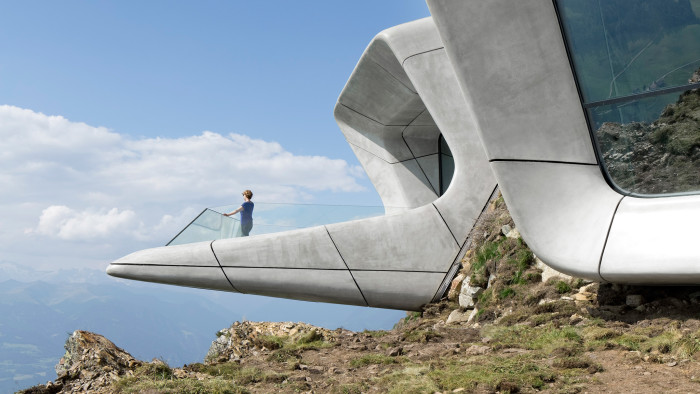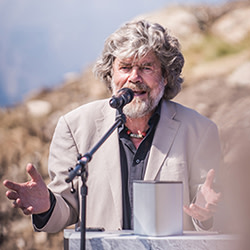Reinhold Messner: King of the mountains

Simply sign up to the Life & Arts myFT Digest -- delivered directly to your inbox.
Sitting in a hilltop restaurant, Reinhold Messner still looks the part of the rock-star mountaineer. The yeti hair and base-camp beard remain luxuriant. At his throat is a Tibetan necklace. Slim and fit, the 70-year-old’s eyes retain a summit gleam.
These days, though, he is more curator than climber. For more than a decade, Messner — the first person to climb Everest solo and without supplementary oxygen, the first to climb all 14 peaks over 8,000 metres, and the most famous mountaineer alive — has been creating a series of museums about mountains, set amid the jagged spires of the Dolomites.
“I’m a storyteller,” he says, when we meet in the Oberraut restaurant, just across the valley from his new museum, the day after its opening. “I do this for the next generations. They have to know what traditional alpinism is all about.”

The sixth and final “Messner Mountain Museum” (MMM), launched on July 24, is as idiosyncratic as the rest: it is a homage to traditional climbing, yet set in a futuristic building designed by the Iraqi-British architect Zaha Hadid, and based on a Messner idea.
The curving concrete structure atop the Kronplatz, a 2,275-metre mountain close to Brunico, could be mistaken for a spaceship that has crashed into the peak and fused with the rock. Most of the building is underground, with only giant “portholes” projecting out of the earth, giving a panoramic view that plunges to the valley below. The building cost about €3m, with specially formed concrete sections being trucked up the mountain and buried on the top. Inside is 1,000 sq metres of space, flowing like mountain streams down over three floors. It houses some of the vast array of mountain art and artefacts that Messner has amassed over half a century. The eclecticism and unusual museum locations are both fascinating and perhaps enough to give some visitors vertigo.
The Ripa Messner Mountain Museum, for example, is set in a medieval castle in Brunico, and contains — among many other things — Asian yurts, African masks, an entire wooden doorway from a mosque in Pakistan and a magnificent Tibetan chest decorated with an image of Milarepa. He was a yogi from 1,000 years ago who is said to have climbed sacred Mount Kailash on the rays of the sun. “He’s a great hero of mine,” says Messner.
In the Firmian museum, set in the mainly 15th-century Sigmundskron fortress in Bolzano, you will find a room dedicated to Buddhism and other religions practiced by mountain peoples, as well as bold modern paintings of high-altitude scenes and the rudimentary crampons of Edward Whymper, who in 1865 made the first ascent of the Matterhorn. Adding to the cultural Magimix, this is South Tyrol, a semi-autonomous region in northern Italy where many people speak German. In the pretty valley towns and hill villages, road signs and menus carry both languages. It’s sometimes hard to remember which country you’re in.

Each Messner museum has a broad theme: Ripa reflects mountain cultures around the world; Firmian explores human endeavours in mountains. In MMM Corones, the latest museum, Messner traces the evolution of climbing from the Victorian Britons who developed alpinism to the tourists who now pay fortunes to be sherpa-ed up Everest. The latter dismays him. “Ninety per cent of the tourists climbing big mountains are on 10 mountains — and one million mountains in the world are empty,” Messner says. “No one is going there. Traditional alpinism is to go where the others are not going and to be self-reliant.”
The new museum venerates that tradition. On display is a unique collection of equipment used by famous climbers over the past 250 years — including a rusty, bent piton that saved Messner’s life in 1968. The climbing memorabilia are blended with art and a small cinema showing eye-popping films by daring young alpinists of the GoPro age.
Like the style of climbing that Messner loves, the museums, which get about 100,000 visitors a year, are not didactic. “I can’t tell people to love mountains,” he says. “They have to find their own way.” Items are labelled, but their significance is often not explained. Instead, the museums are intended to let you free climb, exploring the stories yourself.
But running through them all, in the background, is a single theme: the story of Messner, maverick and mercurial. Though few displays are explicitly autobiographical, the museums and the man are inevitably entwined — not least at Juval, the renovated castle that houses one collection and serves as Messner’s summer home. (It perches on a steep rocky outcrop; finding himself locked out one night, he tried to climb in, fell and fractured his foot).
To make your way up the Messner seam running through the museums, you could hunt down two objects tucked away among the many hundreds. They are a small hammer and an old boot. Not obviously spectacular, but replete with meaning.
In a large display case in the Corones museum, unobtrusive among various other objects, is a piton hammer, about 20cm long, with a wooden handle. The label attached to it simply says: “Paul Preuss, 1911.”
You wouldn’t know it from the display, but that hammer is special to Messner. So much so that it is the inspiration behind all his museums.

In his 20s, Messner, already a leading rock climber, published an essay entitled “Murder of the Impossible”, which decried the increasing use of equipment to overcome the toughest challenges. “Faith in equipment has replaced faith in oneself,” he wrote. His essay went against the grain of all those wanting to use bolts and other gadgets to climb what would otherwise be impossible.
After the essay appeared widely abroad, Messner received a letter from a 96-year-old lady in Austria. “It was handwritten, difficult to read,” he recalls. “She said, ‘Reading your article, I was reminded of my boyfriend, my big love, Pauli.’ ”
Preuss had been a pioneer of the philosophy of relying on skills and courage, not kit. He had a hammer but, Messner tells me, he was totally against putting in pitons if it could be avoided.
“He did two pitons in his life,” says Messner. “One I have, the other is in a [rock] wall I know.” Such a purist approach inevitably carried higher risks; Preuss fell to his death while climbing alone in 1913, aged 27.
Sensing a kindred spirit in Messner, the old lady sent Preuss’s hammer to him — setting one condition: he either had to hand it on after his death to another like-minded climber, or to put it on display. “I had the hammer in my cellar, and always when I saw it, I was thinking, ‘Oh, I have to begin a museum.’ Around this hammer the whole museum idea began to grow.”
Messner tells his stories through a combination of “relics, art and sentences, small pieces of literature, of the philosophers”, he says. The latter are especially present in Firmian. There, for example, you will find a quote from Kurt Tucholsky, a German-Jewish satirist from the early 20th century lamenting even then the decline in adventure: “The mountain is no longer the mountain. Demystified, abruptly dethroned, a three-thousand metre platitude. People get to the top and do not really know what they are doing there.”

For Messner, the point was — and is — not just getting to the top, but the experience of doing so. Only with self-reliance, with exposure far from safety, far from bolts, satphones or rescue helicopters, can you find the deepest experience, he says. That philosophy played a part in a pivotal moment in Messner’s life. In 1970, he was invited to join an expedition to Nanga Parbat, a 8,126-metre peak in Pakistan. His younger brother Günther also made the team.
The aim was to make a first ascent of the Rupal face, a forbidding wall 4,500 metres high. After frustrating delays, the two Messner brothers and a third climber were at the top camp, awaiting a final chance to make a summit bid. A signal from base camp indicated that bad weather was forecast, although the skies looked clear. Reinhold Messner set off alone in the hope of moving fast while the good weather lasted. A few hours later his brother unexpectedly followed and caught him up.
They reached the summit together, but became stuck on the way down. Having both solo-ed their way up, they had no rope to descend a critical pitch. They were totally exposed.
Desperate, they tried to descend the easier Diamir side of the mountain, though they had no food, no water and no camps to head for there. With Reinhold the stronger of the two and leading the way, they became separated. Günther disappeared and Reinhold could find no trace of his brother. Days after leaving the summit, Reinhold finally reached help, frostbitten, shattered, hallucinating and distraught.
In fact, the forecast had been wrong. The storm never arrived: they could have gone together, all roped up.
The tragedy caused huge controversy, sparking claim and counter-claim about what had happened, and prompting criticism of Messner for failing to save his brother. It haunted him for years. Then in 2005, three climbers found Günther’s remains on the Diamir side of Nanga Parbat, including one of his battered leather boots. Reinhold Messner felt vindicated in his account of events.
That boot now sits in a glass case in the Firmian museum. The exhibit is not centre stage, but tucked away in a small stone room, easily missed, part way up one of the old fortress towers. Black-and-white pictures of famous dead climbers line the walls. In the background a chunk of Bob Dylan’s “Blowin’ in the Wind” plays quietly on a loop: “Yes, and how many deaths will it take . . . the answers, my friend, are blowin’ in the wind.”

On the glass case, a small notice simply says, “The boot of Günther Messner, found in 2005 on the Diamir side of Nanga Parbat.” There’s no explanation, no telling of that story.
On a sunny day, South Tyrol must be one of the most civilised places on earth. Its apple orchards run arrow-straight. Its mountain restaurants serve fine food and excellent, locally produced Pinot Blanc. You can hike, cycle or go rafting, then dine al fresco admiring views of the valleys. It’s a world away from the “death zone” above 8,000 metres.
But if you go prepared, if you approach the museums with self-reliance, you will learn about mountain cultures around the world — and you may also get a glimpse into the complex, rarefied life of arguably the greatest climber of modern times.
Who knows how it might affect you. One of the writings that Messner has chosen to exhibit stuck in my mind. It was from the philosopher Friedrich Nietzsche, and was displayed in the Firmian museum not far from where Günther’s boot resides. It says, “And if you gaze for long into the abyss, the abyss gazes into you.”
Photographs: Werner Huthmacher; Messner Mountain Museum; Getty; FotoRiva
Letter in response to this report
How Messner and Habeler climbed Mount Everest together / From John Liczbinski

Comments